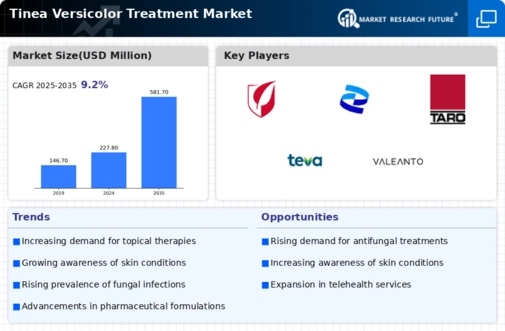Market Share
Tinea Versicolor Treatment Market Share Analysis
Market share positioning strategies are very important in shaping the competitive landscape and affecting the success of different actors in the industry, within this dynamic landscape of Tinea Versicolor Treatment Market. Due to a yeast-like fungus causing tinea versicolor, which is a common skin condition; it has created more demand for effective treatment thus resulting into an upsurge of market activities. In order to gain a portion of the market, companies in this field employ various methods such as product differentiation and pricing and distribution tactics.
One strategy that seems to be common is product innovation and differentiation. The pharmaceutical companies spend heavily on research and development to come up with new effective treatments for Tinea Versicolor. Therefore, by giving innovative solutions that have enhanced efficacy or unique formulations; they will stand out in the crowded market hence capturing the attention of health care providers and consumers at large thereby earning their loyalty. They can also command premium prices through these innovations establishing a strong market position based on perceived value of their products.
Pricing strategies are another important factor that should be considered while discussing market share positioning within Tinea Versicolor Treatment Market. To get more customers many enterprises choose competitive pricing by positioning their products as affordable alternatives. Some other companies may go for premium pricing strategy where they put emphasis on quality and efficacy of their treatments so as to attract high end clients who require more sophisticated products. It is crucial for firms to strike balance between price and perceived value because it determines both profitability and market share. Furthermore strategic partnerships with either healthcare providers or insurance companies can facilitate wider customer reach through alignment with affordability as well as reimbursement considerations.
Distribution channels form another key aspect of market share positioning strategies. Effective and extensive distribution networks are vital to ensuring timely availability of Tinea Versicolor treatments at health facilities and among end-users. Businesses may join established pharmaceutical distributors or retail chains through partnership for increased market access purposes. Moreover selective pharmacies or online platforms create opportunities for widening accessibility and meeting different consumer preferences.
Lastly, marketing and promotional activities also contribute to market share positioning. Product benefits, clinical outcomes and safety profiles need to be effectively communicated via various channels such as medical conferences, digital platforms and traditional media for awareness creation and building brand equity. In addition, strong relationships with healthcare professionals e.g. dermatologists or GPs can play an important role towards gaining endorsements or referrals hence further affecting the market share.
For purposes of marketing and sales in line with changing customer tastes, firms may resort to the use of digital technologies. This allows direct interaction between companies and clients thereby promoting product education as well as getting customer feedback through different online platforms like websites, social media networks as well as e-commerce channels. Consequently, integration of digital marketing into their strategies gives these organizations competitive advantage over other market players thereby increasing their overall market shares in a way that expands their target groups beyond geographical boundaries.”








Leave a Comment